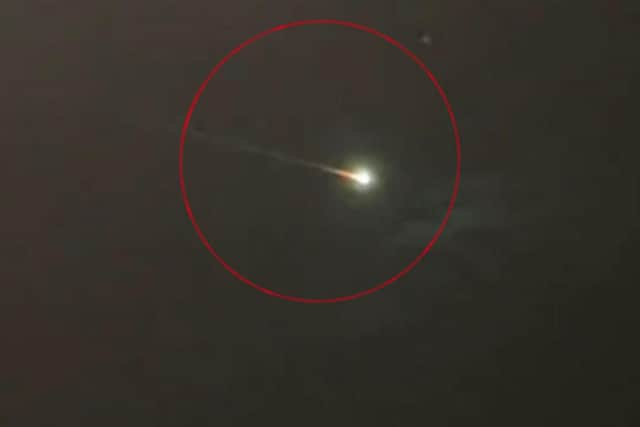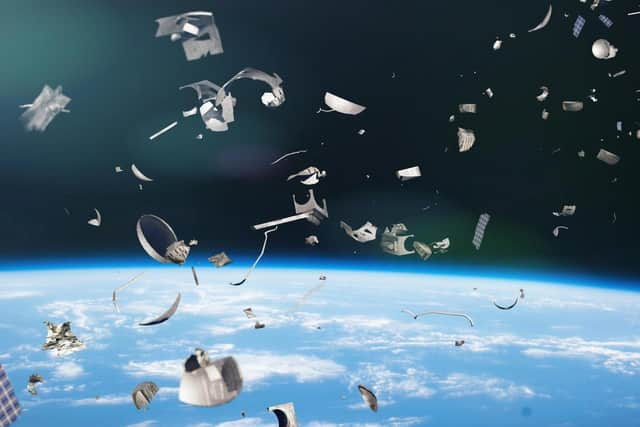Huge ‘Meteor’ seen in Scotland crashed with a ‘bang’: What was it? Where did it land? Is it a meteor or space junk?
The UK Meteor Network confirmed that over 800 people reported witnessing the ‘astronomical sighting’ at 9pm on Wednesday across Scotland and Northern Ireland.
Videos capturing the celestial phenomenon were taken at the same time from several different locations, showing how huge and bright the “fireball” was.
What was the “fireball” seen over Scotland?


Advertisement
Hide AdAdvertisement
Hide AdAfter hundreds of submitted videos, and a network of 170 detection cameras dedicated to recording meteors and other celestial phenomena over Britain’s sky, the UK Meteor Network has confirmed that the object, that was seen in the sky for over 20 seconds, was “definitely a meteor.”
What is the difference between a meteor and space debris?
According to NASA, meteoroids (that become ‘meteors’ when they enter Earth’s atmosphere) are space objects that range in size from small asteroids to petite grains, they can be thought of as “space rocks”.
A shooting star is an example of a meteor that can visibly be seen entering our atmosphere.


Space debris refers to artificial and non-functional objects or fragments that float in orbit or re-enter the Earth’s atmosphere.
The European Space Agency also refers to space debris as “space junk”.
How can you tell the difference between a meteor and space junk?
Meteors and space junk can both burn similar colours and intensities as meteors often contain many elements or alloys found in artificial objects, so a quick glance can’t confirm what’s what.
However, the velocity of the object can tell us a lot more.
Most space junk that re-enters Earth’s atmosphere travels at roughly 25-30 thousand kilometres per hour while meteors travel much faster, reaching speeds of 70 to 80 thousand kilometres per hour.
The UK Meteor Network confirmed on Twitter that the meteor spotted on Wednesday “came on an asteroidal orbit and entered the atmosphere at 14.2 km/s.”
This equates to roughly 51 thousand kilometres per hour.
Where did the meteor crash?
Advertisement
Hide AdAdvertisement
Hide AdSteve Owens, science communicator at the Glasgow Science Centre and an astronomer, witnessed the fireball as it streaked over the sky in Scotland on Wednesday evening, September 14.
While speaking on BBC Radio Scotland’s ‘Good Morning Scotland’ programme he said it was possible it may have landed in Scotland but it is “highly unlikely.”
He said: “The UK Meteor Network, which has had hundreds of reports from around Scotland and further afield, is going to be able to triangulate all of those reports to work out its trajectory.
“It looked to me like it was heading… it was certainly heading towards the west and, given that people in Northern Ireland were reporting seeing it, it could well have passed over land and ended up in the Atlantic, but it’s certainly not impossible that it landed – finding it will be the challenge.”
The network said the end of the meteor’s trajectory was not caught on camera but is expected to have ended in the North Atlantic Ocean, roughly 50-100km west of the Isle of Islay.
Can meteors be dangerous?
Although meteors frequently make their way into Earth’s atmosphere they rarely cause any harm or issues for people.
According to NASA, it is only every 2,000 years or so that a major meteoroid - like the size of a football field - hits Earth and causes “significant damage” to the surrounding area.
When Software Developer Stuart Padley asked the UK Meteor Network if the meteor seen in Scotland would have made a crater on impact and if so how large of one, the network answered: “Probably none. It was quite small.”
Comments
Want to join the conversation? Please or to comment on this article.
